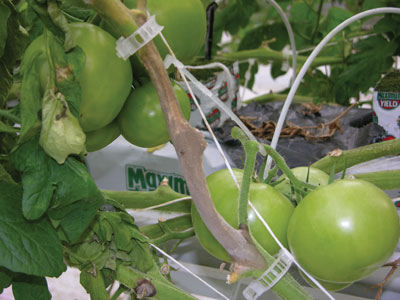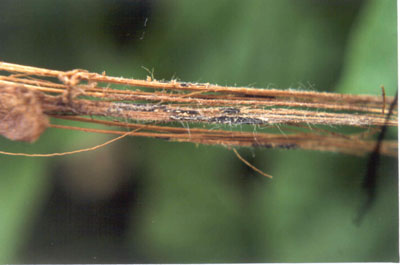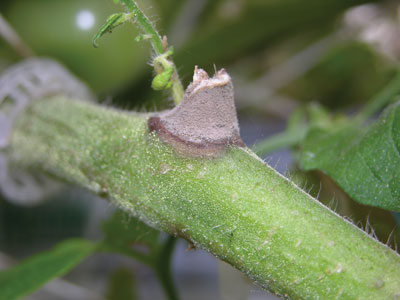
Features
Crop Protection
Inputs
Greenhouse Grower notes: Botrytis infection on tomato stems
January 28, 2011 By Gillian Ferguson
Botrytis grey mould, caused by the fungus Botrytis cinerea, occurs
commonly in greenhouse crops and a variety of small fruits, herbs and
ornamentals, etc. Not only is B. cinerea widespread, but it can survive
between crops under unfavourable conditions by means of resistant
survival structures called sclerotia.
Botrytis grey mould, caused by the fungus Botrytis cinerea, occurs commonly in greenhouse crops and a variety of small fruits, herbs and ornamentals, etc. Not only is B. cinerea widespread, but it can survive between crops under unfavourable conditions by means of resistant survival structures called sclerotia.
 |
|
| Tomato plant killed by enlarged wound infected by Botrytis cinerea. PHOTOS COURTESY GILLIAN FERGSON, OMAFRA Advertisement
|
These fungal structures can remain viable for up to 20 years in dried plant material, and can produce spores when suitable environmental conditions return.
Consequently, many growers can count on appearance of this fungus in the crop, particularly tomato crops. Although B. cinerea can attack all plant parts in tomato crops, stem wounds are usually the primary target sites. This article elaborates on how a few elements of the environment and the plant host may influence development of stem infections caused by B. cinerea in tomato crops. Most of the data provided are based on research done in Israel, and reported in 1997.
Inoculum level – Inoculum level refers to the amount of infection sources, particularly spores. Research done in Israel demonstrated that only as few as 10 spores applied to stem wounds can cause infection. High spore levels (1,000 and 10,000 spores per stem) resulted in very high incidences of infection (75 and 95 per cent) at 10 days after inoculation. When inoculum levels were 10 to 100 spores per stem, incidence of infection was reduced to seven and 20 per cent, respectively.
SPORE-CONTAMINATED DROPLETS COULD BE A SOURCE OF INFECTION
■ Other researchers have reported that water droplets produced when water drips onto Botrytis-infected bean leaves contained up to 150 spores per droplet. Thus, spore-contaminated droplets within a commercial house could serve as a source of infection for wounds on tomato plants.
 |
|
| Botrytis sclerotia: old tomato stem showing black sclerotia embedded between the fibrous tissue.
|
An important source of inoculum is decaying leaves on the floor left long after emergence of parasitoids. Such rotting debris provide an abundance of food source for development and sporulation by B. cinerea. Research has shown that spore counts of B. cinerea decreased in greenhouses in which picked leaves were removed immediately compared to greenhouses in which the leaves were left on the floor.
Effect of VPD – VPD, or vapour pressure deficit, refers to the drying power of the air. A low VPD is equivalent to an environment with high relative humidity and vice versa. Having a low VPD and, often, having the accompanying free moisture on plant surfaces are considered the most important environmental factors for promoting infections by B. cinerea.
HEATING AND VENTING TO REDUCE CONDENSATON ISSUES
■ The Israeli study found that the practice of heating and venting to reduce condensation of moisture on the plants is apparently effective against infection of leaves, flowers and fruit, but not against stem infections. The reason is the moisture supplied by the wound itself may be sufficient to support germination of B. cinerea spores and the initial process of penetration. However, although stem infection can occur under high VPD (i.e., dry conditions), the production of spores is suppressed. Such suppression of spore production should slow down the progress of any epidemic by B. cinerea.
Age of wound – Research done to study the effect of wound age on susceptibility to infection on tomato stems indicated that highest infection in wounds by the fungus occurred between zero to nine hours after cutting (incidence 60 to 70 per cent). Infection decreased to two to eight per cent when wounds were kept in a dry atmosphere for about 24 hours prior to inoculation.
COMPLETE DESUCKERING AND DEFOLIATION EARLY IN THE DAY
■ This type of data provides the basis for the recommendation to complete desuckering and defoliation activities sufficiently early in the day to facilitate drying of the wounds before sunset. If wounding occurs late in the day, the moist cut surfaces can collect spores that will be sucked into the stem when transpiration resumes the next day. Such spores can remain hidden without causing infection until after about 10 to 12 weeks when physiological conditions in the plant favour their development.
 |
|
| Stem wound: tomato stem wound infected by Botrytis cinerea showing profuse production of spores
|
Bottom line – We need to continue managing the climate so as to minimize plant wetness, but given that stem wounds can get infected even in a well-managed climate, attention to minimizing inoculum sources (i.e., maintaining good sanitation practices) is equally important. Note also that anything that will increase wound healing will reduce the amount of stem infection.
Gillian Ferguson, greenhouse vegetable IPM specialist, OMAFRA, Harrow. • Gillian.ferguson@ontario.ca;
Ray Cerkauskas, greenhouse vegetable pathologist, AAFC, Harrow. • Raymond.cerkauskas@agr.gc.ca.
Print this page